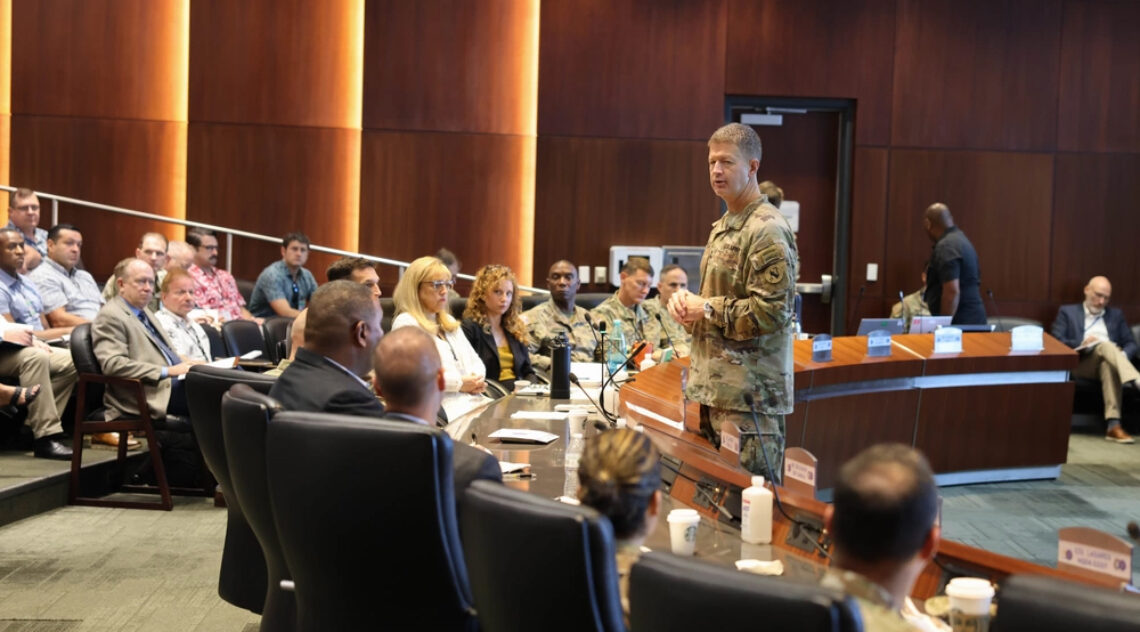
U.S. Army Pacific welcomed record-breaking attendance for the largest ever Artificial Intelligence/Machine Learning Summit in the Frederick C. Weyand Command Center on Fort Shafter, Hawaii, Oct. 25-26, 2023.
This year’s summit, the third iteration of the annual event, showed a substantial increase in participants, more than tripling last year’s tally of 44 to over 150 external attendees.
“One thing I’ve learned over my career is that the best way to come to the optimal solution is to have a diverse group of folks working on the problem,” said Lt. Gen. James B. Jarrard, USARPAC deputy commanding general, during his opening remarks. “We are asking you to be teammates as we try to solve these problems together. We’re not going to solve all the problems in the next couple of days, but hopefully, we will understand the problems better and identify some leadership to take ownership of those issues.”
The effort demonstrated USARPAC’s aim to unify the AI/ML Community of Interest, composed of military, private sector, and academic personnel, under a shared purpose to address its challenges and capability gaps where AI/ML capabilities can be integrated to enable data-driven decision-making and reduce decision cycle timelines.
By increasing engagement with the AI/ML community and through continued experimentation, USARPAC hopes to reach its goal to outpace threats in the Indo-Pacific region through technological advancements.
“This is a unique opportunity to bring in a wide audience,” said Maj. Josh Deehr, the USARPAC Chief Data Office deputy director. “We’re having people from all service components and from research centers across the Department of Defense participate, including the Office of the Secretary of Defense Chief Data and Analytical Office.”
Deehr added, “We’re also bringing in academia so people can gain an appreciation for the challenges we face in the Pacific. By bringing everybody together for an annual summit, we can have a better understanding of not only what people are doing within USARPAC but across the DoD, in academia, and in the federally funded research and development centers, so that we can capitalize on and synchronize our efforts to have a unified path forward.”
USARPAC has an experimentation and concepts branch to drive experimentation integration throughout the execution of Operation Pathways to fully recognize the needs of Soldiers in competition, crisis, and conflict. This year’s summit will also look to capitalize on lessons learned from Operation Pathways to focus efforts on advancing or improving specific targeted areas using AI/ML techniques, tools, and methodologies.
The summit featured four main working groups where participants focused on curating or improving an AI/ML development and integration campaign plan on the following topics: Logistical Common Operational Picture, Network Modeling and Simulation, Foreign Disclosure
Decision Support Tools and Enhancing the Digital Kill Chain. The campaign plans for each of these areas will be integrated into the overall Army Campaign Plan.
The Logistical Common Operational Picture working group covered optimizing naval logistics in contested environments, augmenting traditional human-designed embedded diagnostics with machine learning, sustainment of the theater’s ammunition inventory, and advanced supply chain analytics and visualizations.
The Foreign Disclosure Decision Support Tools working group discussed enhanced tactical and artificial reasoning and AI-assisted situation report generation.
The Network Modeling and Simulation working group discussed discovering hidden behaviors in binary software applications and the Air Mobility Command’s persistent digital environment.
The Enhancing Digital Kill Chain working group focused on correlating order-of-battle movement patterns for learned event exploitation, combining information content with embedding relationship optimization, and synthetic data for AI/ML.
All working groups discussed the above mentioned topics and more.
“Listening to all the different partners within this industry, whether Massachusetts Institute of Technology Research and Engineering or the different research labs, got me excited about the possibilities for the future,” said Capt. Jennifer Niemann, with the U.S. Army Artificial Intelligence Integration Center. “Partnering technical experts with people who have the Army knowledge makes the discussions really productive because you don’t usually have much of both in the room together.”
By gathering like-minded individuals with a collective mission, USARPAC is one step closer to solidifying its place as a leader in an ever-evolving technological landscape.
“This summit was a great opportunity to meet with folks, not only within the Army but across the DoD,” said Myron Hohil, the senior scientific technical manager for Artificial Intelligence at Picatinny Arsenal Development Command Armaments Center. “It was an excellent venue for discussing key items within USARPAC that are of interest and discussing a variety of different approaches to solve problems.”